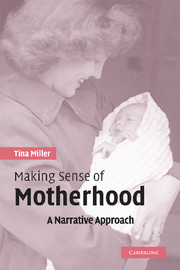Book contents
- Frontmatter
- Contents
- Dedication
- Acknowledgements
- Introduction
- 1 The storied human life: a narrative approach
- 2 Making sense of motherhood: cultural scripts
- 3 Setting the Western context: mothering in late-modern society
- 4 Anticipating motherhood: the antenatal period
- 5 Making sense of early mothering experiences
- 6 A return to normal: becoming the expert
- 7 Conclusions and reflections: making sense of motherhood
- References
- Index
2 - Making sense of motherhood: cultural scripts
Published online by Cambridge University Press: 22 September 2009
- Frontmatter
- Contents
- Dedication
- Acknowledgements
- Introduction
- 1 The storied human life: a narrative approach
- 2 Making sense of motherhood: cultural scripts
- 3 Setting the Western context: mothering in late-modern society
- 4 Anticipating motherhood: the antenatal period
- 5 Making sense of early mothering experiences
- 6 A return to normal: becoming the expert
- 7 Conclusions and reflections: making sense of motherhood
- References
- Index
Summary
I've heard people talking, like you know they are embarrassed and feel shamed the way they check out you especially with your first baby … it's because they're so different they've never seen these sorts of things before.
(Munia, commenting on the experiences of recently immigrated Bangladeshi women receiving antenatal care in the UK)The different and sometimes competing cultural scripts that shape ways of knowing about reproduction and childbirth in different cultural contexts were powerfully demonstrated to me at the time of the birth of my first daughter. During the 1980s I had lived in Dhaka, the capital of Bangladesh, for two and a half years. I worked at a children's hospital and spent time in the ‘bustees’, the urban slums. My job involved tracing former inpatients of the hospital in order to assess their nutritional status. Following an eventful pregnancy (see Introduction) I returned home to England for the birth of my first child. The morning after my daughter was born in the local National Health Service hospital, I was aware of a commotion in the next bed. The new mother, by coincidence a young Bangladeshi woman, was in a state of bewilderment. The two auxiliary nurses she was appealing to had failed with sign language and were looking slightly bemused. I was able to interpret for her; she was in pain and thirsty.
- Type
- Chapter
- Information
- Making Sense of MotherhoodA Narrative Approach, pp. 27 - 45Publisher: Cambridge University PressPrint publication year: 2005

